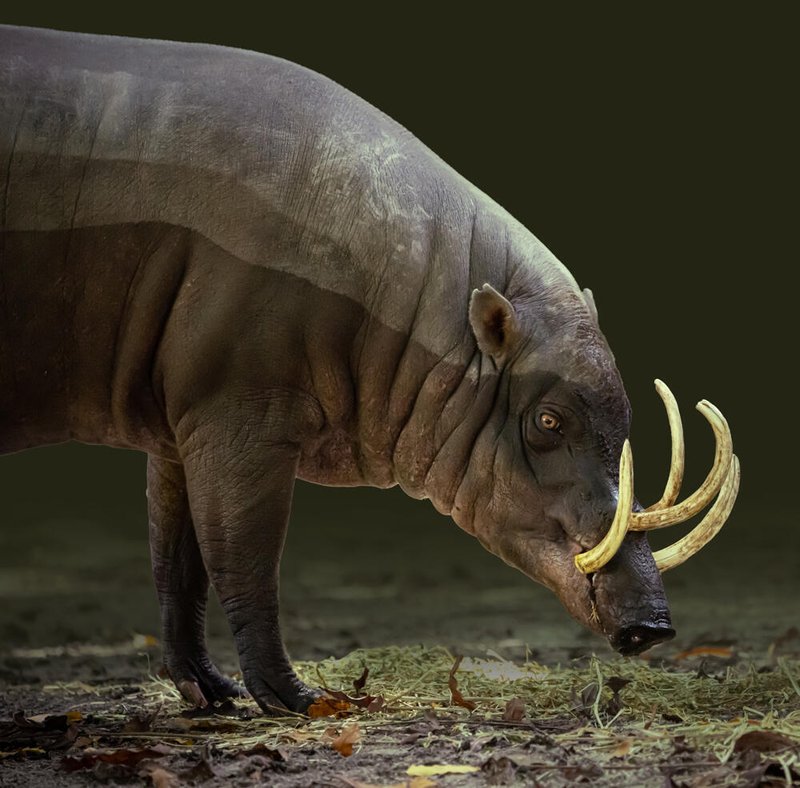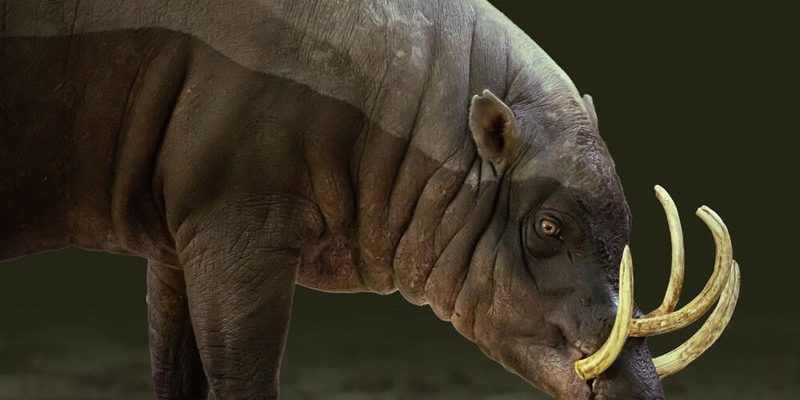
Have you ever heard of a creature that’s part pig and part deer? This fascinating animal is called the Babirusa. Native to the lush islands of Indonesia, it has some truly unique features that set it apart from its more common relatives. Imagine a creature that walks with the gait of a pig but possesses tusks that curve upwards like horns. The Babirusa isn’t just intriguing to look at; it has a rich ecological role that fascinates anyone who delves into its world.
So, what exactly is a Babirusa? Its name translates to “pig-deer” in Malay, and it belongs to a group of animals called swine. However, it’s quite different from your typical farm pig. For starters, they have striking long tusks, which can grow to impressive lengths. These tusks are not just for show; they play a significant role in males’ social interactions and mating displays.
In this article, we will explore the Babirusa in detail, from its unique physical traits to its habitat and behavior. You might be surprised by how little the Babirusa is known outside its native range and how important it is to the ecosystem it inhabits.
Physical Characteristics
The Babirusa is not your average pig. When you see one, you might be captivated by its unusual appearance. They have a slim, agile body that can weigh between 80 to 100 pounds, typically standing about 2 to 3 feet tall at the shoulder. One of their most defining features is their elongated, upward-curving tusks, which can protrude dramatically, especially in males. These tusks can grow throughout their lives, sometimes even piercing their own skulls if not worn down properly. Isn’t that wild?
These animals are covered in coarse bristles rather than fur, giving them a slightly shaggy appearance. Their coloration can range from grayish-brown to a lighter tan, blending beautifully into their forest environments. Their large, expressive eyes and ears are adaptations to help them navigate dense jungles and locate food, making them quite adorable in a unique way.
Interestingly, the Babirusa also has a unique dental structure. They possess a set of molars that are quite different from other pigs, which helps them grind down tough vegetation. This diet primarily consists of fruits, leaves, and roots, showcasing their role as herbivores in the ecosystem. Their physical form is not just fascinating; it serves a purpose in their survival among the dense forests they call home.
Habitat and Distribution
Babirusas are endemic to Indonesia, primarily found on the islands of Sulawesi, Togian, Sula, and Buru. They thrive in tropical rainforests, which provide ample food and cover from predators. The dense vegetation is essential, offering both a diet rich in natural resources and a habitat where they can hide from potential threats. The Babirusa’s preference for these humid environments is a big part of what makes them so unique.
These islands are known for their rich biodiversity, and the Babirusa plays an important role in maintaining this balance. By consuming fruits and plants, they help with seed dispersal, contributing to forest regeneration. Imagine a natural gardener, spreading seeds wherever they roam, allowing new plants to grow. This behavior illustrates their importance beyond mere survival; they are key players in their ecosystem.
Unfortunately, as their habitats face increasing threats from agriculture and deforestation, the Babirusa’s future is at risk. Conservation efforts are crucial to maintaining their populations and the health of their environments. Protecting these beautiful creatures ensures that our planet continues to thrive with biodiversity.
Diet and Feeding Behavior
The diet of the Babirusa mainly consists of fruits, leaves, and roots, making them herbivores with a penchant for foraging. They have a keen sense of smell, which helps them locate food buried under the forest floor. When you think about it, foraging through the underbrush is like a treasure hunt—they rely on their senses to guide them to their next meal.
During the day, Babirusas are often seen rooting around in the earth, using their snouts to dig up tubers and other food sources. This behavior not only aids in their nutrition but also helps aerate the soil, benefiting the surrounding plant life. Their ability to adapt their diet depending on the season is a significant advantage, allowing them to thrive in a challenging environment.
Though they are generally solitary animals, they can sometimes be seen foraging in small groups. When this happens, it’s not uncommon for them to engage in friendly displays of social behavior, further solidifying their bonds. In these moments, you can observe a dynamic interplay that highlights both their need for social connection and their unique ecological role.
Reproduction and Life Cycle
Reproduction in Babirusas is quite fascinating. Breeding typically occurs during the rainy season, which aligns with the availability of fresh food resources. After a gestation period of about 150 days, a female Babirusa usually gives birth to one or two piglets. These little ones are born with a full coat of bristly fur to help them adapt to their surroundings right from the start.
The young are quite vulnerable initially, needing their mother’s protection as they learn to navigate the forest. Babirusas are relatively attentive mothers, and the bond between them and their offspring is quite strong. Over the first few months, the piglets gradually learn to forage and develop the skills necessary for survival in the wild. This nurturing phase is crucial for their development, as they learn the ropes from their mother.
Interestingly, males typically reach sexual maturity around 2 to 3 years old. However, their extraordinary tusks make them more attractive to females, and males will often display their tusks as part of courtship rituals. This fascinating courtship process highlights the unique aspects of Babirusa social structures and interactions. As with many species, the journey from piglet to adult is a critical one, filled with lessons from the environment and family.
Conservation Status
The Babirusa is classified as vulnerable by the International Union for Conservation of Nature (IUCN). Their populations have been declining due to habitat loss, hunting, and other human activities. Deforestation for agriculture and logging is a significant threat, reducing the amount of natural habitat available to them. If trends continue, we risk losing this unique species and the role it plays in its ecosystem.
Conservation efforts are underway to protect the Babirusa and its habitat. Organizations are working with local communities to promote sustainable practices that benefit both the environment and the people living nearby. Education is key; by raising awareness of the Babirusa’s plight, we can encourage more people to contribute to conservation efforts.
Protected areas and national parks are also essential in safeguarding Babirusa habitats. These regions serve as sanctuaries where they can thrive away from the threats posed by urban development. Preserving these areas not only benefits the Babirusa; it also fosters a rich biodiversity that is essential for maintaining the health of our planet.
Interesting Facts About Babirusa
| Scientific Name: | Babi rosu |
| Size: | 2 to 3 feet tall at the shoulder |
| Weight: | 80 to 100 pounds |
| Diet: | Herbivore (fruits, leaves, roots) |
| Lifespan: | Up to 15 years in the wild |
| Habitat: | Tropical rainforests of Indonesia |
FAQ
What does the Babirusa eat?
The Babirusa is primarily an herbivore, feeding on a variety of plants. Their diet includes fruits, leaves, and roots, and they often forage in the forest floor. This foraging behavior not only helps them find food but also benefits the ecosystem by aerating the soil.
Where can you find Babirusas in the wild?
Babirusas are native to several islands in Indonesia, most notably Sulawesi, Togian, Sula, and Buru. They thrive in tropical rainforests, which provide them with the resources they need for survival and reproduction.
Are Babirusas social animals?
While Babirusas are generally solitary, they can sometimes be seen foraging in small groups. They engage in social behaviors, particularly during mating displays, where males will often show off their impressive tusks.
What threats do Babirusas face?
The primary threats to Babirusas include habitat loss due to deforestation and hunting. With their natural environment shrinking, the Babirusa’s chances of survival are decreasing, leading to their classification as vulnerable by the IUCN.
How long do Babirusas live?
In the wild, Babirusas can live for up to 15 years. Their lifespan can vary based on environmental conditions and threats from predators, as well as their access to food and mating opportunities.
Why are Babirusas important to their ecosystem?
Babirusas play a crucial role in their ecosystem primarily through seed dispersal. As they consume fruits and other plants, they help maintain the health of the forest by allowing new plants to grow, contributing to the overall biodiversity of their habitat.
Can Babirusas be kept in captivity?
Yes, Babirusas can be kept in captivity, such as in zoos or wildlife reserves. However, it’s essential that their enclosures mimic their natural habitats to ensure they remain healthy and exhibit natural behaviors. Conservation programs often use captive Babirusas to educate the public about the species and its conservation needs.
Do Babirusas have any natural predators?
In their natural habitat, Babirusas face threats from larger predators, including big cats and crocodiles. However, humans pose the most significant threat through hunting and habitat destruction, making it crucial to protect this unique species.
Are Babirusas solitary or social animals?
Babirusas are generally solitary but can show social behavior, particularly during mating seasons. They may form small groups while foraging, but they typically prefer to roam alone in the wild.
What are the defining features of a Babirusa?
Some of the most defining features of Babirusas include their long, upward-curving tusks and their slim, agile body structure. They are also known for their coarse bristles rather than fur, which gives them a unique appearance compared to other pig species.
What is the conservation status of the Babirusa?
The Babirusa is classified as vulnerable by the IUCN. They are threatened by habitat loss and hunting, making conservation efforts crucial to ensuring their survival in the wild.
How do Babirusas reproduce?
Babirusas typically breed during the rainy season, with females giving birth after a gestation period of about 150 days. Mothers care for their young during the early months, teaching them essential survival skills in the forest.
Can you see Babirusas in zoos?
Yes, Babirusas are sometimes housed in zoos or wildlife reserves, where they can be seen by the public. These institutions play a vital role in conservation efforts, helping to raise awareness and support for the protection of this unique species.
What are baby Babirusas like?
Baby Babirusas are born with a full coat of bristly fur, making them well-adapted to life in their natural habitat. They rely heavily on their mothers for protection and learning as they grow, which is crucial for their survival.

